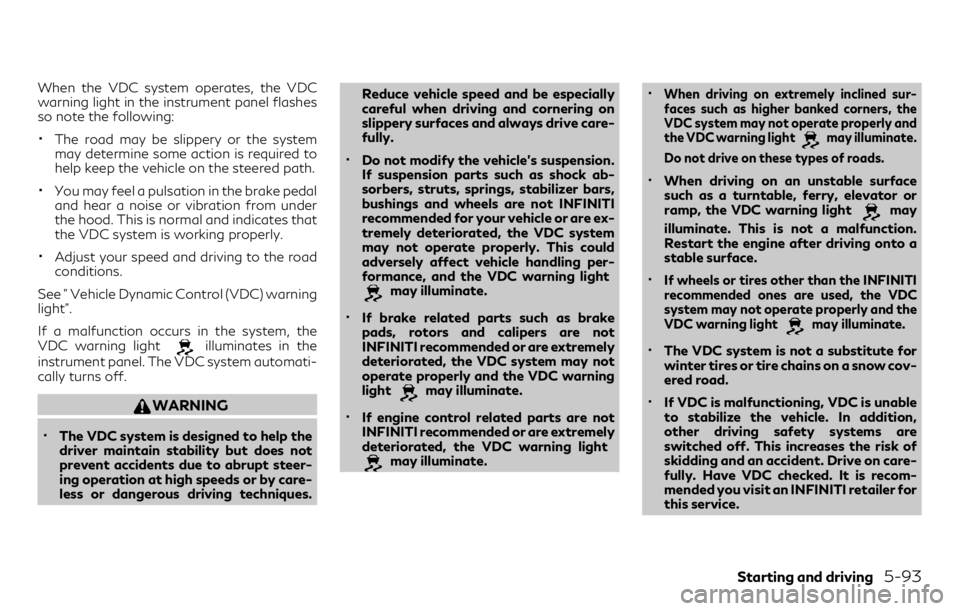brake pads INFINITI QX30 2018 Owner's Manual
[x] Cancel search | Manufacturer: INFINITI, Model Year: 2018, Model line: QX30, Model: INFINITI QX30 2018Pages: 438, PDF Size: 5.58 MB
Page 112 of 438
![INFINITI QX30 2018 Owners Manual Message Possible causes/consequences and solutions
[Check Brake Fluid Level]There is insufficient brake fluid in the brake fluid reservoir.
In addition, the redwarning light lights up in the combinati INFINITI QX30 2018 Owners Manual Message Possible causes/consequences and solutions
[Check Brake Fluid Level]There is insufficient brake fluid in the brake fluid reservoir.
In addition, the redwarning light lights up in the combinati](/img/42/35107/w960_35107-111.png)
Message Possible causes/consequences and solutions
[Check Brake Fluid Level]There is insufficient brake fluid in the brake fluid reservoir.
In addition, the redwarning light lights up in the combination meter and a warning tone sounds.
1. Pull over and stop the vehicle safely as soon as possible, paying attention to road and traffic conditions. Do not continue driving
under any circumstances.
2. Secure the vehicle against rolling away.
3. Check the brake fluid level. If brake fluid is necessary, add fluid and have the system checked. It is recommended you visit an
INFINITI retailer for this service. See "Brake fluid".
4. If the brake fluid level is correct, have the warning system checked. It is recommended you visit an INFINITI retailer for this
service.
WARNING•Your brake system may not be working properly if the warning light is on. Driving could be dangerous. If you judge it to be safe,
drive carefully to the nearest service station for repairs. Otherwise, have your vehicle towed because driving it could be
dangerous.
•Pressing the brake pedal with the engine stopped and/or low brake fluid level may increase your stopping distance and braking
will require greater pedal effort as well as pedal travel.
•If the brake fluid level is below the minimum or MIN mark on the brake fluid reservoir, do not drive until the brake system has
been checked. It is recommended you visit an INFINITI retailer for this service.
[Check Brake Pad Wear]The brake pads/linings have reached their wear limit.
It is recommended you visit an INFINITI retailer.
2-36Instruments and controls
Page 318 of 438

SYSTEM MAINTENANCE
CAUTION
Keep the surface of the sonar sensors (if
equipped) (located on the front and rear
bumper fascia) free from accumulations of
snow, ice and dirt. Do not scratch the sur-
face of the sonar sensors when cleaning. If
the sensors are covered, the accuracy of
the sonar function will be diminished.During the first 1,200 miles (2,000 km), fol-
low these recommendations to obtain maxi-
mum engine performance and ensure the fu-
ture reliability and economy of your new
vehicle. Failure to follow these recommenda-
tions may result in shortened engine life and
reduced engine performance.
•Avoid driving for long periods at constant
speed, either fast or slow, and do not run
the engine over 4,000 RPM.
•Do not accelerate at full throttle in any
gear.
•Avoid quick starts.
•Avoid hard braking as much as possible.
•Do not tow a trailer for the first 500 mi
(805 km). Your engine, axle or other parts
could be damaged.
You should also observe these notes on
break-in if the engine or parts of the drive
train on your vehicle have been replaced.
CAUTION
In certain driving and driving safety sys-
tems, the sensors adjust automatically
while a certain distance is being driven af-
ter the vehicle has been delivered or after
repairs. Full system effectiveness is not
reached until the end of this teach-in pro-
cess.
Brake pads/linings and rotors that are ei-
ther new or have been replaced only
achieve optimum braking effect after sev-
eral hundred miles of driving. Compensate
for the reduced braking effect by applying
greater force to the brake pedal
BREAK-IN SCHEDULE
5-84Starting and driving
Page 324 of 438

•Do not place the ignition switch in the on
position while the steering wheel or a
tire is removed.
•Do not turn the steering wheel as much
as possible while the ignition switch is in
any position other than the ON position.
•Installing an accessory on the steering
wheel, or changing the steering wheel,
may reduce the steering performance.
NOTE
When the steering wheel is operated repeat-
edly or continuously while parking or driving
at a very low speed, the power assistance for
the steering wheel will be reduced. This is to
prevent overheating of the electric power
steering system and protect it from becom-
ing damaged. While the power assistance is
reduced, steering wheel operation will be-
come heavy. When the temperature of the
electric power steering system decreases,
the power assistance level will return to nor-
mal. Avoid repeating such steering wheel
operations that could cause the electric
power steering system to overheat.The brake system has two separate hydraulic
circuits. If one circuit malfunctions, you will
still have braking ability at two wheels.
BRAKE PRECAUTIONS
WARNING
While driving on a slippery surface, be
careful when braking, accelerating or
downshifting. Abrupt braking or acceler-
ating could cause the wheels to skid and
result in an accident.
Vacuum assisted brakes
The brake booster aids braking by using en-
gine vacuum. If the engine stops, you can
stop the vehicle by depressing the brake
pedal. However, greater foot pressure on the
brake pedal will be required to stop the ve-
hicle. The stopping distance will be longer.
WARNING
•If the engine is not running or is turned
off while driving, the power assist for
the brakes will not work. Braking will be
harder.
•Do not coast with the engine stopped.When the brake pedal is depressed slowly
and firmly, you may hear a clicking noise and
feel a slight pulsation. This is normal and
indicates that the Brake Assist System is op-
erating (if equipped).
Using brakes
Avoid resting your foot on the brake pedal
while driving. This will overheat the brakes,
wear out the brake linings/pads faster, and
increase fuel consumption.
To help reduce brake wear and to prevent the
brakes from overheating, reduce speed and
downshift to a lower gear before going down
a slope or long grade. Overheated brakes
may reduce braking performance and could
result in loss of vehicle control.
While driving on a slippery surface, be careful
when braking, accelerating or downshifting.
Abrupt braking or acceleration could cause
the wheels to skid and result in an accident.
Wet brakes
When the vehicle is washed or driven through
water, the brakes may get wet. As a result,
your braking distance will be longer and the
vehicle may pull to one side during braking.
To dry the brakes, drive the vehicle at a safe
speed while lightly depressing the brake
pedal to heat up the brakes. Do this until the
BRAKE SYSTEM
5-90Starting and driving
Page 327 of 438

When the VDC system operates, the VDC
warning light in the instrument panel flashes
so note the following:
•The road may be slippery or the system
may determine some action is required to
help keep the vehicle on the steered path.
•You may feel a pulsation in the brake pedal
and hear a noise or vibration from under
the hood. This is normal and indicates that
the VDC system is working properly.
•Adjust your speed and driving to the road
conditions.
See " Vehicle Dynamic Control (VDC) warning
light".
If a malfunction occurs in the system, the
VDC warning light
illuminates in the
instrument panel. The VDC system automati-
cally turns off.
WARNING
•The VDC system is designed to help the
driver maintain stability but does not
prevent accidents due to abrupt steer-
ing operation at high speeds or by care-
less or dangerous driving techniques.Reduce vehicle speed and be especially
careful when driving and cornering on
slippery surfaces and always drive care-
fully.
•Do not modify the vehicle’s suspension.
If suspension parts such as shock ab-
sorbers, struts, springs, stabilizer bars,
bushings and wheels are not INFINITI
recommended for your vehicle or are ex-
tremely deteriorated, the VDC system
may not operate properly. This could
adversely affect vehicle handling per-
formance, and the VDC warning light
may illuminate.
•If brake related parts such as brake
pads, rotors and calipers are not
INFINITI recommended or are extremely
deteriorated, the VDC system may not
operate properly and the VDC warning
light
may illuminate.
•If engine control related parts are not
INFINITI recommended or are extremely
deteriorated, the VDC warning light
may illuminate.
•When driving on extremely inclined sur-
faces such as higher banked corners, the
VDC system may not operate properly and
the VDC warning light
may illuminate.
Do not drive on these types of roads.
•When driving on an unstable surface
such as a turntable, ferry, elevator or
ramp, the VDC warning light
may
illuminate. This is not a malfunction.
Restart the engine after driving onto a
stable surface.
•If wheels or tires other than the INFINITI
recommended ones are used, the VDC
system may not operate properly and the
VDC warning light
may illuminate.
•The VDC system is not a substitute for
winter tires or tire chains on a snow cov-
ered road.
•If VDC is malfunctioning, VDC is unable
to stabilize the vehicle. In addition,
other driving safety systems are
switched off. This increases the risk of
skidding and an accident. Drive on care-
fully. Have VDC checked. It is recom-
mended you visit an INFINITI retailer for
this service.
Starting and driving5-93
Page 398 of 438

Engine oil and oil filter:
Replace engine oil and oil filter at the speci-
fied intervals. For recommended oil grade
and viscosity refer to "Recommended fluids/
lubricants and capacities".
Fuel filter:
Replace the fuel filter and drain the water at
the specified intervals.
Fuel lines*:
Check the fuel hoses, piping and connections
for leaks, looseness, or deterioration. Tighten
connections or replace parts as necessary.
Spark plugs:
Replace at specified intervals. Install new
plugs of the type as originally equipped.CHASSIS AND BODY
MAINTENANCE
Brake lines and cables:
Visually inspect for proper installation. Check
for chafing, cracks, deterioration, and signs
of leaking. Replace any deteriorated or dam-
aged parts immediately.
Brake pads, rotors, drums, & linings:
Check for wear, deterioration and fluid leaks.
Replace any deteriorated or damaged parts
immediately.
Exhaust system:
Visually inspect the exhaust pipes, muffler
and hangers for leaks, cracks, deterioration,
and damage. Tighten connections or replace
parts as necessary.
In-cabin microfilter:
Replace at specified intervals. When driving
for prolonged periods in dusty conditions, re-
place the filter more frequently.
Propeller shaft(s):
Check for damage, looseness, and grease
leakage. (4WD/AWD).Steering gear and linkage, axle and suspen-
sion parts, drive shaft boots:
Check for damage, looseness, and leakage of
oil or grease.
Tire rotation:
Tires should be rotated every 5,000 miles
(8,000 km) according to the instructions un-
der "Tire rotation*" earlier in this section.
When rotating tires, check for damage and
uneven wear. Replace if necessary.
Transmission fluid/oil, differential oil, trans-
fer case oil:
Visually inspect for signs of leakage at speci-
fied intervals.
9-6Maintenance and Schedules
Page 403 of 438

CHASSIS & BODY MAINTENANCE
Abbreviations: I = Inspect and correct or replace as necessary, R = Replace
MAINTENANCE OPERATIONmiles x 1,000MAINTENANCE INTERVAL
Perform at number of miles, kilometers or
months, whichever comes first.51015202530354045505560
(km x 1,000) (8) (16) (24) (32) (40) (48) (56) (64) (72) (80) (88) (96)
months 6 12 18 24 30 36 42 48 54 60 66 72
Brake lines and cables I I I I I I
Brake pads and rotors I I I I I I
Brake fluidRRR
Automatic transmission fluid I I I
Automatic transmission fluid and filter Replace every 60,000 miles or 60 months
Differential gear oil I I I I I I
Steering gear and linkage, axle and
suspension partsIII
Tire rotation See NOTE (1)
Propeller shaft & drive shaft boots (4WD
models)II IIII
Exhaust systemIII
In-cabin microfilterRRR
I-key battery R R R R
NOTE:
(1) Refer to "Tire rotation*" earlier in this section.
Maintenance and Schedules9-11
Page 404 of 438

Abbreviations: I = Inspect and correct or replace as necessary, R = Replace
MAINTENANCE OPERATIONmiles x 1,000MAINTENANCE INTERVAL
Perform at number of miles, kilometers or
months, whichever comes first.65 70 75 80 85 90 95 100 105 110 115 120
(km x 1,000) (104) (112) (120) (128) (136) (144) (152) (160) (168) (176) (184) (192)
months 78 84 90 96 102 108 114 120 126 132 138 144
Brake lines and cables I I I I I I
Brake pads and rotors I I I I I I
Brake fluidRR R
Automatic transmission fluid I I I
Automatic transmission fluid and filter Replace every 60,000 miles or 60 months
Differential gear oil I I I I I I
Steering gear and linkage, axle and suspen-
sion partsII I
Tire rotation See NOTE (1)
Propeller shaft & drive shaft boots (4WD
models)II II I I
Exhaust systemII I
In-cabin microfilterRR R
I-key battery R R R R
NOTE:
(1) Refer to "Tire rotation*" earlier in this section.
9-12Maintenance and Schedules